Chicken Housing - A DIY Chicken Tractor
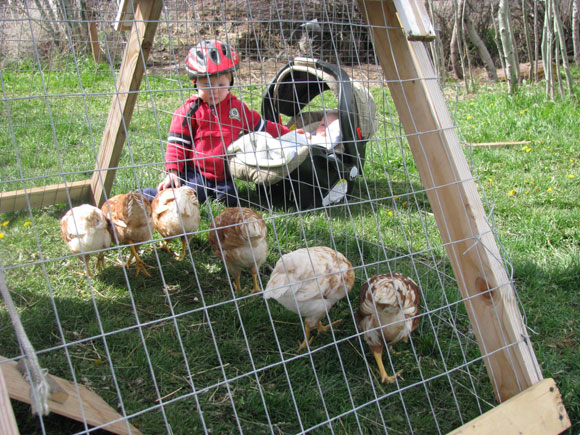
We housed the tiny chicks in a dog kennel in the clinic for the first few weeks of their lives. Jonathen kept a close eye on them.
by Alina Rice
“I think we should build a chicken tractor” my husband announced to me one winter day.
“A what?” I had never heard of a chicken tractor. Besides, we didn’t even own chickens and although folks think Jereld should be an expert at anything that breaths, Gallus Domesticus isn’t high on his specialty list. When I mentioned this, he reassured me that one of our veterinary assistants was practically an expert and that her girls did 4-H projects each year with chickens. Surely we could manage!
From this conversation came a project that encompassed a number of Sunday afternoons, much head scratching, and finally our finished, habitated product: a chicken tractor.
Jereld’s goal in the project, I learned was two-fold: make the thing entirely from scrap material and have eggs by Fall. I was all for the proposal and was excited to start the project. We wanted to have the tractor built by March, when we planned to get our chicks. The tractor would reside at the vet clinic in the back where we had a large grassy area.
We had a great start on the building project –Jonathen our 21 month old son was busy with hammer and nails and Katelyn, our 2 month old daughter supervised from her seat. Jereld initially found the building plans on the Internet, but true to form, we had to change a few things. As the project continued, it took on a life of its own.
Unfortunately, between kids, a very busy veterinary practice, and other life events, we let the chicken tractor slide for a few weeks. The next thing we knew, the beginning of March was here, and so were our chicks.
We got six tiny Bovan chicks, all supposedly female. It was a bitter cold Wallowa County spring and we decided our chicks weren’t ready for the chicken tractor or the outdoors. We set them up in an empty dog kennel in the clinic. Immediately their entertainment value was noticed: Jonathen was entranced by the tiny balls of fluff.
We chose the Bovan breed for a couple of reasons, the first being that our neighbor strongly suggested them. Bovans, we learned are a hybrid with gentle temperaments and incredible egg-laying propensities. We liked both these qualities.
“A what?” I had never heard of a chicken tractor. Besides, we didn’t even own chickens and although folks think Jereld should be an expert at anything that breaths, Gallus Domesticus isn’t high on his specialty list. When I mentioned this, he reassured me that one of our veterinary assistants was practically an expert and that her girls did 4-H projects each year with chickens. Surely we could manage!
From this conversation came a project that encompassed a number of Sunday afternoons, much head scratching, and finally our finished, habitated product: a chicken tractor.
Jereld’s goal in the project, I learned was two-fold: make the thing entirely from scrap material and have eggs by Fall. I was all for the proposal and was excited to start the project. We wanted to have the tractor built by March, when we planned to get our chicks. The tractor would reside at the vet clinic in the back where we had a large grassy area.
We had a great start on the building project –Jonathen our 21 month old son was busy with hammer and nails and Katelyn, our 2 month old daughter supervised from her seat. Jereld initially found the building plans on the Internet, but true to form, we had to change a few things. As the project continued, it took on a life of its own.
Unfortunately, between kids, a very busy veterinary practice, and other life events, we let the chicken tractor slide for a few weeks. The next thing we knew, the beginning of March was here, and so were our chicks.
We got six tiny Bovan chicks, all supposedly female. It was a bitter cold Wallowa County spring and we decided our chicks weren’t ready for the chicken tractor or the outdoors. We set them up in an empty dog kennel in the clinic. Immediately their entertainment value was noticed: Jonathen was entranced by the tiny balls of fluff.
We chose the Bovan breed for a couple of reasons, the first being that our neighbor strongly suggested them. Bovans, we learned are a hybrid with gentle temperaments and incredible egg-laying propensities. We liked both these qualities.
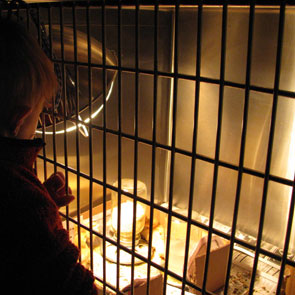
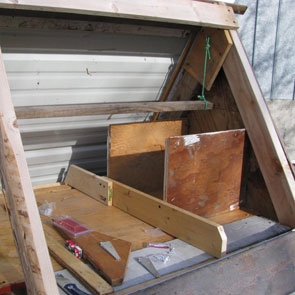
We housed the tiny chicks in a dog kennel in the clinic for the
first few weeks of their lives. Jonathen kept a close eye on them.
This view shows one side of the roof still off with three laying
boxes built into the end. The roosting bar is hanging from
the ridge.
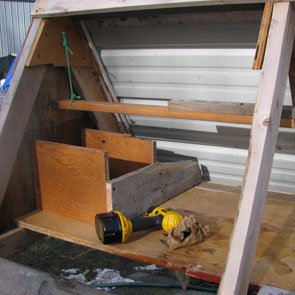
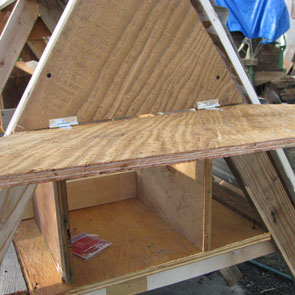
This view shows the two-laying box end with the hole for the
ramp.
Here you can see the door to access the three-laying box end.
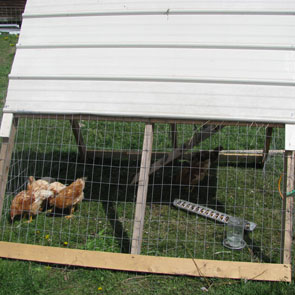
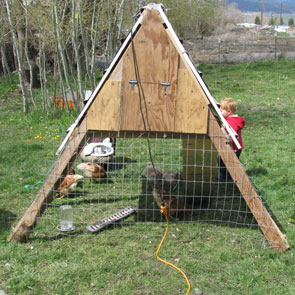
This side of the roof is on hinges so it lifts to access the interior
of the upstairs.
Thanks to a cold Wallowa County spring, we kept a heating lamp on day and night.
Because our chicks were in an easily viewable location, we literally watched them grow. I could not believe how rapidly these little gals changed, shed their chicky down, and grew real big hen feathers. In a matter of weeks, those six girls were pooping to beat the ban and we knew we needed to get them outside and quick! Our clinic help was not too impressed with the chicken poop factor.
We finished up our tractor, put the growing pullets in and watched them go nuts over the growing green grass. And then came the horrible weather of April. In fact, we got more snow in April and early May than had fallen all winter. Our chickens would NOT be able to handle the cold: we were sure of this. They needed some warmth, and the heat lamp wouldn’t be sufficient. We decided to move the tractor in the barn and hunker down for warmer weather.
The tractor is an incredibly efficient design – made for movability and space conservation. The A-frame construction gives them maximized space “downstairs” to eat grass, and a warm, cozy place “upstairs” to lay eggs, stay warm, and get in out of the weather. The highlights of the tractor are the following:
The structure weighs less than 100 pounds, which allows to people to easily move it around. We move it on average every two to three days to give the hens fresh grass.
One side of the roof opens up on hinges, allowing easy access to the roosting pole (for catching chickens at night) as well as for cleaning. This access is also used to pull the ramp up at night, or when the tractor is moved.
Both triangle ends of the upstairs area open to allow access to the laying boxes for quick egg-gathering. The bottom of the A-frame is enclosed with chicken wire. We reinforced the bottom with 1”x4”’s to help keep critters from digging under the wire.
We left one corner of the wire free to access the grazing area for watering and feeding purposes.
At this point, the pullets are still growing like mad. Our Border Collies watch them incessantly, which drives me nuts, but the chickens don’t seem to mind them at all. The chickens are proving to be quite friendly and will let Jonathen pet their backs when they are near the fence. They are supposed to start laying at 17 weeks, so we still have a little time to wait for that first warm, brown egg. I can’t wait to see Jonathen’s face when we collect the first egg. I will certainly have to watch that he doesn’t throw it at his sister…
We finished up our tractor, put the growing pullets in and watched them go nuts over the growing green grass. And then came the horrible weather of April. In fact, we got more snow in April and early May than had fallen all winter. Our chickens would NOT be able to handle the cold: we were sure of this. They needed some warmth, and the heat lamp wouldn’t be sufficient. We decided to move the tractor in the barn and hunker down for warmer weather.
The tractor is an incredibly efficient design – made for movability and space conservation. The A-frame construction gives them maximized space “downstairs” to eat grass, and a warm, cozy place “upstairs” to lay eggs, stay warm, and get in out of the weather. The highlights of the tractor are the following:
The structure weighs less than 100 pounds, which allows to people to easily move it around. We move it on average every two to three days to give the hens fresh grass.
One side of the roof opens up on hinges, allowing easy access to the roosting pole (for catching chickens at night) as well as for cleaning. This access is also used to pull the ramp up at night, or when the tractor is moved.
Both triangle ends of the upstairs area open to allow access to the laying boxes for quick egg-gathering. The bottom of the A-frame is enclosed with chicken wire. We reinforced the bottom with 1”x4”’s to help keep critters from digging under the wire.
We left one corner of the wire free to access the grazing area for watering and feeding purposes.
At this point, the pullets are still growing like mad. Our Border Collies watch them incessantly, which drives me nuts, but the chickens don’t seem to mind them at all. The chickens are proving to be quite friendly and will let Jonathen pet their backs when they are near the fence. They are supposed to start laying at 17 weeks, so we still have a little time to wait for that first warm, brown egg. I can’t wait to see Jonathen’s face when we collect the first egg. I will certainly have to watch that he doesn’t throw it at his sister…
![]()
Author
Alina Rice lives in Joseph, Oregon. She and her veterinarian husband, Jereld operate Enterprise Animal Hospital, gaze in admiration at their six beautiful chickens, and stay on their toes raising their two-year-old son, Jonathen and 5 month old daughter, Katelyn.
This article appeared in the Summer 2010 issue of Rural Heritage magazine.
This article appeared in the Summer 2010 issue of Rural Heritage magazine.
